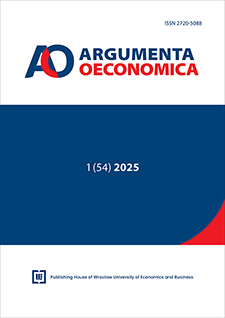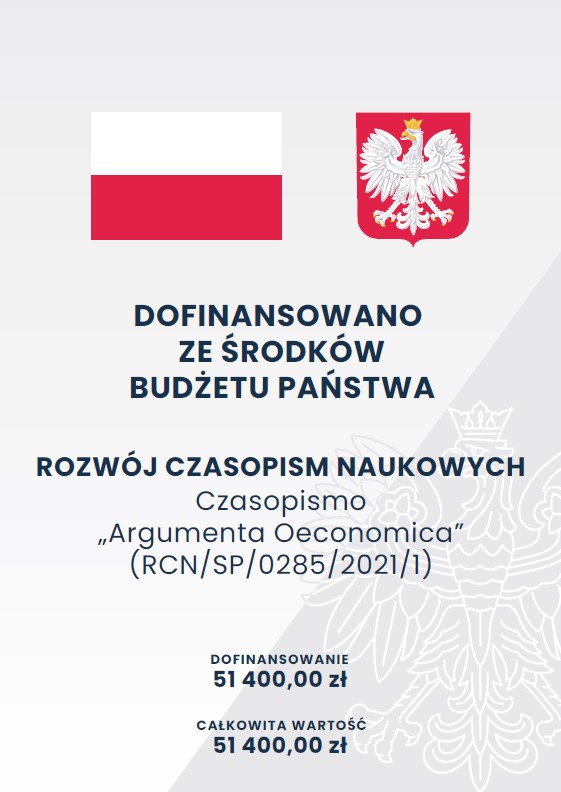The Czech National Bank’s monetary policy since 2008 and its (un)intended consequences in the long run
DOI:
https://doi.org/10.15611/aoe.2025.1.13Keywords:
foreign exchange intervention, quantitative theory of money, inflation, monetary aggregates, Czech National Bank, Czech Republic/CzechiaAbstract
Aim: The article aims to show that the monetary policy of the Czech National Bank (CNB) between 2008 and 2021 was mainly expansionary, especially due to foreign exchange interviews realized by the bank from November 2013 to April 2017 to prevent CZK appreciation. The policy contributes to higher Czech inflation from the first half of 2022 to the first half of 2024.
Methodology: The relationships between monetary aggregates (M1, M2 and M3 and the stock of CNB foreign exchange reserves) and between the reserves, money stock and inflation are statistically investigated. The article uses, among others, the Augmented Dickey-Fuller test and F-test of the ANOVA procedure. It also discusses how household consumption and government expenditure, mainly in the period since 2021, contributed to the Czech inflation.
Results: The study revealed the strong dependence of the development of Czech monetary aggregates (both M1 and M2, and M3) on the development of the stock of the CNB’s foreign exchange reserves. It further proved, using the quantitative equation of money, that the growth of Czech money stock, although partly offset by the negative value of Czech money velocity growth rate, led to the increase in Czech inflation numbers.
Originality/value: The article emphasizes that although monetary policy, including forecasts of economic development, focuses on a period that usually does not exceed two years from taking a specific monetary policy step (e.g. a decision by the central bank to increase or decrease rates) or from the publication of a forecast, i.e. the monetary policy horizon covers up to two years, especially if an expansionary monetary policy is carried out for a longer period. Thus, a central bank should evaluate such a policy, including the issue of how the growth of the value of monetary aggregates can influence inflation values behind the monetary policy horizon. The article further proved that money is neutral in the long run and money growth higher than the growth rate of real GDP must inevitably lead to an increase in inflation. Thus, the CNB expansionary monetary policy had some (un)intended consequences and the central bank faced in the period 2022-2024 higher inflation.
Downloads
References
Abate, T. W. (2020). Macroeconomic determinants of recent inflation in Ethiopia. Journal of World Economic Research, 9(2), 136-42. https://doi.org/10.11648/j.jwer.20200902.17
Akerlof, G. A., Blanchard, O., Romer, D., & Stiglitz, J. (2014). What have we learned? Macroeconomic policy after the crisis. MIT Press. https://doi.org/10.5089/9780262027342.071
Akinboade, O. A, Siebrits F. K., & Niedermeier, E., W. (2004). The determinants of inflation in South Africa: An Econometric Analysis. AERC.
Alichi, A., Benes, J., Felman, J., Feng, I., Freedman, C., Laxton, D., Tanner, E., Vavra, D. & Hou W. (2015). Frontiers of monetary policymaking: adding the exchange rate as a tool to combat deflationary risks in the Czech Republic. (IMF Working Paper, 15/74) International Monetary Fund. https://www.imf.org/external/pubs/ft/wp/2015/wp1574.pdf
Atil, A., & Mourad S. (2020). Determinants of inflation in Algeria: Analysis with a vector error correction model from 2001 to 2016. ASJP, 7, 429-44.
Atkin, T., & La Cava G. (2017). The transmission of monetary policy: how does it work? Bulletin of the Reserve Bank of Australia, September Quarter, 1-8.
Ball, L., Mankiw, G. N., & Romer, D. (1988). The new Keynesian economics and the output-inflation trade-off. Brookings Papers on Economic Activity, 19(1), 1-82.
Bernanke, B. S. (2020). The new tools of monetary policy. American Economic Review, 110(4), 943-83. http://dx.doi.org/10.1257/aer.110.4.943
Blanchard, O. 2021. Macroeconomics. 8th edition. Pearson.
Brčák, J., & Křížek, D. (2021). Support for export as a non-standard central bank policy: foreign exchange interventions in the case of the Czech Republic. Eastern Journal of European Studies, 12(1), 191-218. https://doi.org/10.47743/ejes-20210108
Bui, T. T. (2023). Measuring monetary policy in emerging economy: The role of monetary condition index. Ekonomický časopis, 70(6), 499-522. https://doi.org/10.31577/ekoncas.2022.06.02
Bui, T. T., & Gábor K. D. (2021). Measuring monetary policy by money supply and interest rate: Evidence from emerging economies. Review of Economic Perspectives, 21(3), 347-367. https://doi.org/10.2478/revecp-2021-0015
Bullard, J. (1999). Testing long-run monetary neutrality propositions: Lessons from the recent research. Federal Reserve Bank St. Louis Review, 81(6), 57-77. https://doi.org/10.20955/r.81.57-78
Buthelezi, E. M. (2023). Impact of money supply in different states of inflation and economic growth in South Africa. Economies 2023, 11(2), 64. https://doi.org/10.3390/economies11020064
Cavusoglu, N. (2010). Exchange rates and the effectiveness of actual and oral official interventions: A survey on findings, issues and policy implications. Global Economy Journal, 10(4).
Cerra, V., Fatás, A., & and Saxena, S. C. (2023). Hysteresis and business cycles. Journal of Economic Literature, 61(1), 181-225. http://dx.doi.org/10.1257/jel.20211584
Cogley, T., & Sbordone, A. M. (2008). Trend inflation, indexation, and inflation persistence in the new Keynesian Phillips curve. American Economic Review, 98(5), 2101-26. https://doi.org/10.1257/aer.98.5.2101
Congdom, T. (2024). The Quantity Theory of Money: A New Restatement. Institute of Economic Affairs. Cottrell, A. (2018). Notes on the Taylor Rule. Wake Forest University.
Costa, S. (2000). Monetary condition index. Economic Bulletin and Financial Stability Report Articles and Banco de Portugal Czech National Bank. (2022). Monetary Policy Report – Summer 2022. Czech National Bank. https://www.cnb.cz/en/monetary-policy/monetary-policy-reports/Monetary-Policy-Report-Summer-2022/Economic Studies. Banco de Portugal, Economics and Research Department.
Czech National Bank (n.d.a). Monetary policy instruments. Czech National Bank. https://www.cnb.cz/en/monetarypolicy/instruments/
Czech National Bank (n.d.b). Bank Board decisions. Czech National Bank. https://www.cnb.cz/en/monetary-policy/bankboard-decisions
Czech National Bank (n.d.c). Harmonized monetary aggregates in the Czech Republic. Czech National Bank. https://www.cnb.cz/en/statistics/money_and_banking_stat/methodological-notes/harmonised-monetary-aggregatesin-the-czech-republic/
Czech National Bank (n.d.d). CNB international reserves. Czech National Bank. https://www.cnb.cz/en/cnbnews/calendar/CNB-international-reserves-00018 Czech Statistical Office, (2025). GDP by the expenditure approach. Czech Statistical Office. https://apl.czso.cz/pll/rocenka/rocenkavyber.makroek_vydaj_en
Czech Statistical Office (n.d.a). Summary on Czechia. Czech Statistical Office. https://csu.gov.cz/summary-data-on-the-czechrepublic?pocet=10&start=0&skupiny=32&razeni=-datumVydani
Czech Statistical Office (n.d.b). Inflation - Types, Definition, Tables. Czech Statistical Office. https://csu.gov.cz/inflation_rate
Czech Statistical Office (n.d.c). Notification of government deficit and debt. Czech Statistical Office. https://csu.gov.cz/notification_of_government_deficit_and_debt_ggs
Del Negro, M., Lenza, M., Primiceri, G. E., & Tambalotti, A. (2020). What’s up with the Phillips curve? Brookings Papers on Economic Activity, Spring 2020, 1-57.
Dorman, P. (2014). Macroeconomics: A fresh start. Springer. European Banking Federation. (2011). EU banking sector: the world’s largest banking system in the world’s largest economic space. European Banking Federation.
Enders, W. (2015). Applied econometric time series 4th edition. University of Alabama.
Federal Reserve. (n.d.). What is the money supply? Is it important? Federal Reserve. https://www.federalreserve.gov/faqs/money_12845.htm
Filardo, A.; Gelos, R. G, & McGregor, T. (2022). Exchange-rate swings and foreign currency intervention. (IMF Working Paper, 22/158). International Monetary Fund. https://www.imf.org/en/Publications/WP/Issues/2022/07/28/Exchange-RateSwings-and-Foreign-Currency-Intervention-521039
Frait, J. (2023). Monetární makroekonomie a centrální banky v turbulentních dobách (Monetary macroeconomics and central banks in turbulent times). Czech National Bank. https://www.cnb.cz/cs/verejnost/servis-pro-media/vystoupenikonference-seminare/prezentace-a-vystoupeni/Monetarni-makroekonomie-a-centralni-banky-v-turbulentnich-dobach
Frait, J., & Matějů, J. (2023, March 2). The current monetary conditions in the Czech Republic: Tight or easy? Czech National Bank. https://www.cnb.cz/en/about_cnb/cnblog/The-current-monetary-conditions-in-the-Czech-Republic-tight-oreasy/
Friedman, M. (1968). The role of monetary policy. Presidential address delivered at the 80th Annual Meeting of the American Economic Association. American Economic Review, 58(1), 1-15.
Friedman, M. (1989). Quantity theory of money (pp. 1-40). In Money. Palgrave Macmillan.
Galí, J. (2015). Monetary policy, inflation, and the business cycle: an introduction to the new Keynesian framework and its applications. Princeton University Press.
Gharehgozli O., & Lee, S. (2022). Money supply and inflation after COVID-19. Economies, 10(5), 101, https://doi.org/10.3390/economies10050101
Ghosh, A. R., Ostry, J. D., & Chamon, M. (2016). Two targets, two instruments: Monetary and exchange rate policies in emerging market economies. Journal of International Money and Finance, 60, 172-196. https://doi.org/10.1016/j.jimonfin.2015.03.005
Hledík, T., Holub, T., & Král, P. 2016. The Czech National Bank’s role since the global crisis. Public Finance Quarterly, 61(1), 65-93.
Jordà, Ò., Singh, S. R, & Taylor. A. M. (2023). The long-run effects of monetary policy (NBER Working Paper No. 26666). National Bureau of Economic Research. https://www.nber.org/system/files/working_papers/w26666/w26666.pdf
Keynes, J. M. (1936). The general theory of employment, interest and money. Macmillan.
Koo, R. C. (2012). The holy grail of macroeconomics. Wiley. https://doi.org/10.1002/9781119199618
Koppl, R. (2014). From crisis to confidence: Macroeconomics after crash. Institute of Economic Affairs.
Kubíček, J., & Morda. P. (2023). Fiskální deficit a emise peněz v ČR v době pandemie covidu-19. Politická ekonomie, 71(1), 6888. https://doi.org/10.18267/j.polek.1375
Lízal, L., & Schwarz, J. (2017). Foreign exchange interventions as an (un)conventional monetary tool: preliminary assessment (pp. 319-342). In Proceedings from The Twelfth International Conference: Innovative responses for growth and competitiveness. Faculty of Economics, University of Split.
Lucas, R. E., Jr. (1996). Nobel lecture: Monetary neutrality. Journal of Political Economy, 104(4), 661-682. Michl, A. (2023). Ten years later: lessons for DSGE builders and Czech policy makers. Review of Economic Perspectives, 19(3), 159-174. https://doi.org/10.2478/revecp-2019-0009
Michl, A. (2019, June 15). The road to the target II. Czech National Bank. https://www.cnb.cz/en/public/mediaservice/speeches-conferences-seminars/presentations-and-speeches/The-road-to-the-target-II/
Mishkin, F. S. (2009). Is monetary policy effective during financial crises? American Economic Review, 99(2), 573-77. https://doi.org/10.1257/aer.99.2.573
Mndebele, S, Tewari, D. D., & Ilesanmi. K. D. (2023). Testing the validity of the quantity theory of money on sectoral data: Non-linear evidence from South Africa. Economies, 11(2), 71. https://doi.org/10.3390/economies11020071
Ogachi, D., Mugambi, P., Bares, L., & Zeman, Z. (2021). Idiosyncrasies of money: 21st century evolution of money. Economies, 9(1), 40. https://doi.org/10.3390/economies9010040 Rasool, H., & Tarique M. (2017). Determinants of inflation: evidence from India using autoregressive distributed lagged approach. Asian Journal of Research in Banking and Finance, 8(1), 1-17.
Rajan, R. (2023). For central banks, less is more: More focused, less interventionist central banks would likely deliver better outcomes. Finance & Development, March 2023, 11-14.
Rasure, E., & Munichiello, K. (2022, April 28). What is quantitative easing (QE), and how does it work? Investopedia. https://www.investopedia.com/terms/q/quantitative-easing.asp
Starnes, D. S., & Tabor, J. (2014). The practice of statistics. 5th edition, W. H. Freeman
Svensson, L. (2001). The zero bound in an open economy: A foolproof way of escaping from a liquidity trap. Monetary and Economic Studies, 19(S-1), 277-312. Sweeney, J. & Sweeney, R. J. (1977). Monetary theory and the great Capitol Hill baby-sitting co-op crisis: Comment. Journal of Money, Credit and Banking, 9(1), 86-89. https://doi.org/10.2307/1992001
Svoboda, J. (2014). Foreign exchange intervention by the Czech National Bank. Faculty of Economics and Management, Masaryk University.
Taylor, J. B. (2000). Low inflation, pass-through and the pricing power of firms. European Economic Review, 44(7), 1389-1408. https://doi.org/10.1016/S0014-2921(00)00037-4
Vary, M. (2021). The long-run real effects of monetary shocks: lessons from a hybrid post-Keynesian-DSGE-agent-based menu cost model. Economic Modelling, 105, 105674. https://doi.org/10.1016/j.econmod.2021.105674
Vesna, M. (2020). Intervention strategies in foreign exchange markets. Economic Themes, 58(3), 381-399. https://doi.org/10.2478/ethemes-2020-0022
Wang, X. (2017). The quantity theory of money: An empirical and quantitative reassessment. Washington University.
Wawrosz, P. & Traksel, S. (2023). Negative interest rates and its impact on GDP, FDI and banks’ financial performance: the cases of Switzerland and Sweden. International Journal of Financial Studies, 11(2), 69-91. https://doi.org/10.3390/ijfs11020069
Werning, I. 2022. Expectations and the rate of inflation. (NBER Working Paper No. 30260). National Bureau of Economic Research. https://www.nber.org/system/files/working_papers/w30260/w30260.pdf
Downloads
Published
Issue
Section
License
Copyright (c) 2025 Petr Wawrosz, David Křížek

This work is licensed under a Creative Commons Attribution-ShareAlike 4.0 International License.
Accepted 2024-05-29
Published 2025-05-14








